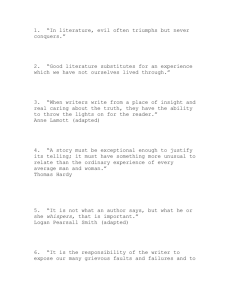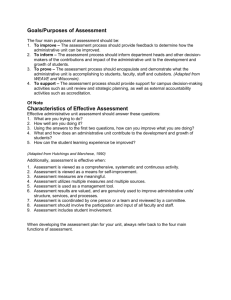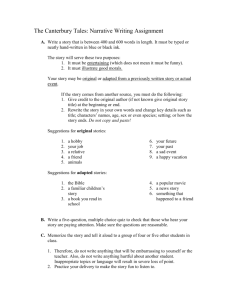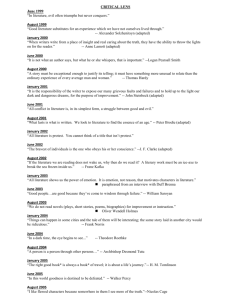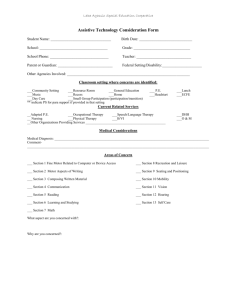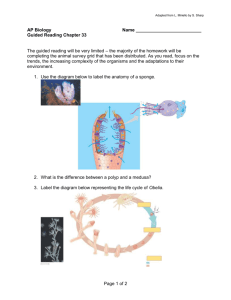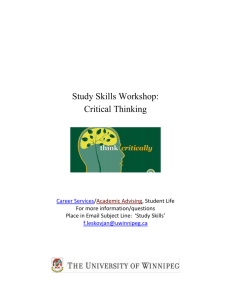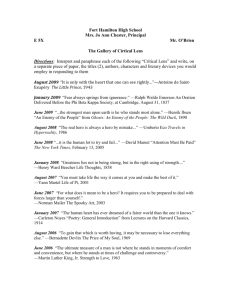Question Answering
advertisement
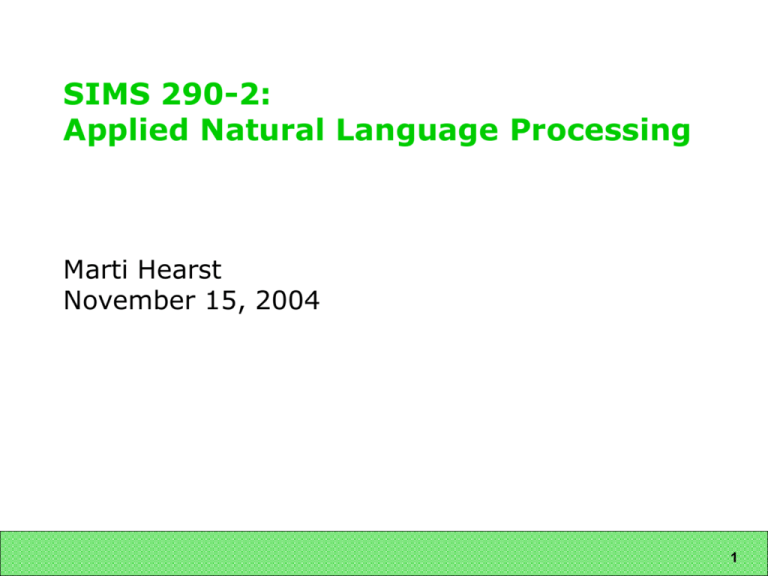
SIMS 290-2:
Applied Natural Language Processing
Marti Hearst
November 15, 2004
1
Question Answering
Today:
Introduction to QA
A typical full-fledged QA system
A very simple system, in response to this
An intermediate approach
Wednesday:
Using external resources
– WordNet
– Encyclopedias, Gazeteers
Incorporating a reasoning system
Machine Learning of mappings
Other question types (e.g., biography, definitions)
2
A
of Search Types
Question/Answer
What is the typical height of a giraffe?
Browse and Build
What are some good ideas for landscaping my
client’s yard?
Text Data Mining
What are some promising untried treatments
for Raynaud’s disease?
3
Beyond Document Retrieval
Document Retrieval
Users submit queries corresponding to their information
needs.
System returns (voluminous) list of full-length documents.
It is the responsibility of the users to find information of
interest within the returned documents.
Open-Domain Question Answering (QA)
Users ask questions in natural language.
What is the highest volcano in Europe?
System returns list of short answers.
… Under Mount Etna, the highest volcano in Europe,
perches the fabulous town …
A real use for NLP
Adapted from slide by Surdeanu and Pasca
4
Questions and Answers
What is the height of a typical giraffe?
The result can be a simple answer, extracted from
existing web pages.
Can specify with keywords or a natural language
query
– However, most web search engines are not set up to
handle questions properly.
– Get different results using a question vs. keywords
5
6
7
8
9
The Problem of Question Answering
When was the San Francisco fire?
… were driven over it. After the ceremonial tie was removed - it burned in the San
Francisco fire of 1906 – historians believe an unknown Chinese worker probably drove
the last steel spike into a wooden tie. If so, it was only…
What is the nationality of Pope John Paul II?
… stabilize the country with its help, the Catholic hierarchy stoutly held out for pluralism,
in large part at the urging of Polish-born Pope John Paul II. When the Pope
emphatically defended the Solidarity trade union during a 1987 tour of the…
Where is the Taj Mahal?
… list of more than 360 cities around the world includes the Great Reef in
Australia, the Taj Mahal in India, Chartre’s Cathedral in France, and
Serengeti National Park in Tanzania. The four sites Japan has listed include…
Adapted from slide by Surdeanu and Pasca
10
The Problem of Question Answering
Natural language question,
not keyword queries
What is the nationality of Pope John Paul II?
… stabilize the country with its help, the Catholic hierarchy stoutly held out for pluralism,
in large part at the urging of Polish-born Pope John Paul II. When the Pope
emphatically defended the Solidarity trade union during a 1987 tour of the…
Short text fragment,
not URL list
Adapted from slide by Surdeanu and Pasca
11
Question Answering from text
With massive collections of full-text documents,
simply finding relevant documents is of limited
use: we want answers
QA: give the user a (short) answer to their
question, perhaps supported by evidence.
An alternative to standard IR
The first problem area in IR where NLP is really
making a difference.
Adapted from slides by Manning, Harabagiu, Kushmeric, and ISI
12
People want to ask questions…
Examples from AltaVista query log
who invented surf music?
how to make stink bombs
where are the snowdens of yesteryear?
which english translation of the bible is used in official catholic
liturgies?
how to do clayart
how to copy psx
how tall is the sears tower?
Examples from Excite query log (12/1999)
how can i find someone in texas
where can i find information on puritan religion?
what are the 7 wonders of the world
how can i eliminate stress
What vacuum cleaner does Consumers Guide recommend
Adapted from slides by Manning, Harabagiu, Kushmeric, and ISI
13
A Brief (Academic) History
In some sense question answering is not a new research area
Question answering systems can be found in many areas of NLP
research, including:
Natural language database systems
– A lot of early NLP work on these
Problem-solving systems
– STUDENT (Winograd ’77)
– LUNAR
(Woods & Kaplan ’77)
Spoken dialog systems
– Currently very active and commercially relevant
The focus is now on open-domain QA is new
First modern system: MURAX (Kupiec, SIGIR’93):
– Trivial Pursuit questions
– Encyclopedia answers
FAQFinder (Burke et al. ’97)
TREC QA competition (NIST, 1999–present)
Adapted from slides by Manning, Harabagiu, Kushmeric, and ISI
14
AskJeeves
AskJeeves is probably most hyped example of
“Question answering”
How it used to work:
Do pattern matching to match a question to their
own knowledge base of questions
If a match is found, returns a human-curated answer
to that known question
If that fails, it falls back to regular web search
(Seems to be more of a meta-search engine now)
A potentially interesting middle ground, but a fairly
weak shadow of real QA
Adapted from slides by Manning, Harabagiu, Kushmeric, and ISI
15
Question Answering at TREC
Question answering competition at TREC consists of answering
a set of 500 fact-based questions, e.g.,
“When was Mozart born?”.
Has really pushed the field forward.
The document set
Newswire textual documents from LA Times, San Jose Mercury
News, Wall Street Journal, NY Times etcetera: over 1M documents
now.
Well-formed lexically, syntactically and semantically (were
reviewed by professional editors).
The questions
Hundreds of new questions every year, the total is ~2400
Task
Initially extract at most 5 answers: long (250B) and short (50B).
Now extract only one exact answer.
Several other sub-tasks added later: definition, list, biography.
Adapted from slides by Manning, Harabagiu, Kushmeric, and ISI
16
Sample TREC questions
1. Who is the author of the book, "The Iron Lady: A Biography of
Margaret Thatcher"?
2. What was the monetary value of the Nobel Peace Prize in 1989?
3. What does the Peugeot company manufacture?
4. How much did Mercury spend on advertising in 1993?
5. What is the name of the managing director of Apricot Computer?
6. Why did David Koresh ask the FBI for a word processor?
7. What is the name of the rare neurological disease with
symptoms such as: involuntary movements (tics), swearing,
and incoherent vocalizations (grunts, shouts, etc.)?
17
TREC Scoring
For the first three years systems were allowed to return 5
ranked answer snippets (50/250 bytes) to each question.
Mean Reciprocal Rank Scoring (MRR):
– Each question assigned the reciprocal rank of the first correct
answer. If correct answer at position k, the score is 1/k.
1, 0.5, 0.33, 0.25, 0.2, 0 for 1, 2, 3, 4, 5, 6+ position
Mainly Named Entity answers (person, place, date, …)
From 2002 on, the systems are only allowed to return a single
exact answer and the notion of confidence has been introduced.
18
Top Performing Systems
In 2003, the best performing systems at TREC can answer
approximately 60-70% of the questions
Approaches and successes have varied a fair deal
Knowledge-rich approaches, using a vast array of NLP
techniques stole the show in 2000-2003
– Notably Harabagiu, Moldovan et al. ( SMU/UTD/LCC )
Statistical systems starting to catch up
AskMSR system stressed how much could be achieved by very
simple methods with enough text (and now various copycats)
People are experimenting with machine learning methods
Middle ground is to use large collection of surface matching
patterns (ISI)
Adapted from slides by Manning, Harabagiu, Kusmerick, ISI
19
Example QA System
This system contains many components used by other systems,
but more complex in some ways
Most work completed in 2001; there have been advances by this
group and others since then.
Next slides based mainly on:
Paşca and Harabagiu, High-Performance Question Answering
from Large Text Collections, SIGIR’01.
Paşca and Harabagiu, Answer Mining from Online
Documents, ACL’01.
Harabagiu, Paşca, Maiorano: Experiments with Open-Domain
Textual Question Answering. COLING’00
20
QA Block Architecture
Extracts and ranks passages
using surface-text techniques
Captures the semantics of the question
Selects keywords for PR
Extracts and ranks answers
using NL techniques
Question Semantics
Q
Question
Processing
Keywords
WordNet
Parser
NER
Adapted from slide by Surdeanu and Pasca
Passage
Retrieval
Document
Retrieval
Passages
Answer
Extraction
A
WordNet
Parser
NER
21
Question Processing Flow
Construction of the
question representation
Q
Question
parsing
Answer type detection
Keyword selection
Adapted from slide by Surdeanu and Pasca
Question
semantic
representation
AT category
Keywords
22
Question Stems and Answer Types
Identify the semantic category of expected answers
Question
Question stem
Answer type
Q555: What was the name of Titanic’s captain?
What
Person
Q654: What U.S. Government agency registers
trademarks?
What
Organization
Q162: What is the capital of Kosovo?
What
City
Q661: How much does one ton of cement cost?
How much
Quantity
Other question stems: Who, Which, Name, How hot...
Other answer types: Country, Number, Product...
Adapted from slide by Surdeanu and Pasca
23
Detecting the Expected Answer Type
In some cases, the question stem is sufficient to indicate the
answer type (AT)
Why REASON
When DATE
In many cases, the question stem is ambiguous
Examples
– What was the name of Titanic’s captain ?
– What U.S. Government agency registers trademarks?
– What is the capital of Kosovo?
Solution: select additional question concepts (AT words)
that help disambiguate the expected answer type
Examples
– captain
– agency
– capital
Adapted from slide by Surdeanu and Pasca
24
Answer Type Taxonomy
Encodes 8707 English concepts to help recognize expected answer type
Mapping to parts of Wordnet done by hand
Can connect to Noun, Adj, and/or Verb subhierarchies
25
Answer Type Detection Algorithm
Select the answer type word from the question representation.
Select the word(s) connected to the question. Some
“content-free” words are skipped (e.g. “name”).
From the previous set select the word with the highest
connectivity in the question representation.
Map the AT word in a previously built AT hierarchy
The AT hierarchy is based on WordNet, with some concepts
associated with semantic categories, e.g. “writer”
PERSON.
Select the AT(s) from the first hypernym(s) associated with a
semantic category.
Adapted from slide by Surdeanu and Pasca
26
Answer Type Hierarchy
PERSON
inhabitant,
dweller, denizen
American westerner
islander,
island-dweller
scientist,
man of science
chemist
researcher
oceanographer
What
PERSON
Hepatitis-B
researcher
discovered
vaccine
What researcher discovered the
vaccine against Hepatitis-B?
Adapted from slide by Surdeanu and Pasca
performer,
performing artist
dancer
actor
ballet
tragedian
actress
dancer
name
PERSON
What
oceanographer
French
Calypso
owned
What is the name of the French
oceanographer who owned Calypso?
27
Evaluation of Answer Type Hierarchy
This evaluation done in 2001
Controlled the variation of the number of WordNet synsets
included in the answer type hierarchy.
Test on 800 TREC questions.
Hierarchy
coverage
0%
3%
10%
25%
50%
Precision score
(50-byte answers)
0.296
0.404
0.437
0.451
0.461
The derivation of the answer type is the main source of
unrecoverable errors in the QA system
Adapted from slide by Surdeanu and Pasca
28
Keyword Selection
Answer Type indicates what the question is looking
for, but provides insufficient context to locate the
answer in very large document collection
Lexical terms (keywords) from the question, possibly
expanded with lexical/semantic variations provide the
required context.
Adapted from slide by Surdeanu and Pasca
29
Lexical Terms Extraction
Questions approximated by sets of unrelated words
(lexical terms)
Similar to bag-of-word IR models
Question (from TREC QA track)
Lexical terms
Q002: What was the monetary value of the Nobel monetary, value, Nobel,
Peace Prize in 1989?
Peace, Prize
Q003: What does the Peugeot company
manufacture?
Peugeot, company,
manufacture
Q004: How much did Mercury spend on
advertising in 1993?
Mercury, spend, advertising,
1993
Q005: What is the name of the managing
director of Apricot Computer?
name, managing, director,
Apricot, Computer
Adapted from slide by Surdeanu and Pasca
30
Keyword Selection Algorithm
1.
2.
3.
4.
5.
6.
7.
8.
Select
Select
Select
Select
Select
Select
Select
Select
all non-stopwords in quotations
all NNP words in recognized named entities
all complex nominals with their adjectival modifiers
all other complex nominals
all nouns with adjectival modifiers
all other nouns
all verbs
the AT word (which was skipped in all previous steps)
Adapted from slide by Surdeanu and Pasca
31
Keyword Selection Examples
What researcher discovered the vaccine against Hepatitis-B?
Hepatitis-B, vaccine, discover, researcher
What is the name of the French oceanographer who owned
Calypso?
Calypso, French, own, oceanographer
What U.S. government agency registers trademarks?
U.S., government, trademarks, register, agency
What is the capital of Kosovo?
Kosovo, capital
Adapted from slide by Surdeanu and Pasca
32
Passage Retrieval
Extracts and ranks passages
using surface-text techniques
Captures the semantics of the question
Selects keywords for PR
Extracts and ranks answers
using NL techniques
Question Semantics
Q
Question
Processing
Keywords
WordNet
Parser
NER
Adapted from slide by Surdeanu and Pasca
Passage
Retrieval
Document
Retrieval
Passages
Answer
Extraction
A
WordNet
Parser
NER
33
Passage Extraction Loop
Passage Extraction Component
Extracts passages that contain all selected keywords
Passage size dynamic
Start position dynamic
Passage quality and keyword adjustment
In the first iteration use the first 6 keyword selection
heuristics
If the number of passages is lower than a threshold
query is too strict drop a keyword
If the number of passages is higher than a threshold
query is too relaxed add a keyword
Adapted from slide by Surdeanu and Pasca
34
Passage Retrieval Architecture
Keywords
Keyword
Adjustment
No
Passage
Quality
Yes
Passages
Passage Extraction
Passage
Scoring
Passage
Ordering
Ranked
Passages
Documents
Document
Retrieval
Adapted from slide by Surdeanu and Pasca
35
Passage Scoring
Passages are scored based on keyword windows
For example, if a question has a set of keywords: {k1, k2, k3, k4}, and
in a passage k1 and k2 are matched twice, k3 is matched once, and k4
is not matched, the following windows are built:
Window 1
Window 2
k1
k2
k2
k3
k1
Window 3
k2
k2
k3
k1
Window 4
k1
k2
k1
k2
k3
k1
Adapted from slide by Surdeanu and Pasca
k1
k2
k2
k3
k1
36
Passage Scoring
Passage ordering is performed using a radix sort that
involves three scores:
SameWordSequenceScore (largest)
– Computes the number of words from the question that
are recognized in the same sequence in the window
DistanceScore (largest)
– The number of words that separate the most distant
keywords in the window
MissingKeywordScore (smallest)
– The number of unmatched keywords in the window
Adapted from slide by Surdeanu and Pasca
37
Answer Extraction
Extracts and ranks passages
using surface-text techniques
Captures the semantics of the question
Selects keywords for PR
Extracts and ranks answers
using NL techniques
Question Semantics
Q
Question
Processing
Keywords
WordNet
Parser
NER
Adapted from slide by Surdeanu and Pasca
Passage
Retrieval
Document
Retrieval
Passages
Answer
Extraction
A
WordNet
Parser
NER
38
Ranking Candidate Answers
Q066: Name the first private citizen to fly in space.
Answer type: Person
Text passage:
“Among them was Christa McAuliffe, the first private
citizen to fly in space. Karen Allen, best known for her
starring role in “Raiders of the Lost Ark”, plays McAuliffe.
Brian Kerwin is featured as shuttle pilot Mike Smith...”
Best candidate answer: Christa McAuliffe
Adapted from slide by Surdeanu and Pasca
39
Features for Answer Ranking
relNMW number of question terms matched in the answer passage
relSP number of question terms matched in the same phrase as the
candidate answer
relSS number of question terms matched in the same sentence as the
candidate answer
relFP flag set to 1 if the candidate answer is followed by a punctuation
sign
relOCTW number of question terms matched, separated from the candidate
answer by at most three words and one comma
relSWS number of terms occurring in the same order in the answer
passage as in the question
relDTW average distance from candidate answer to question term matches
SIGIR ‘01
Adapted from slide by Surdeanu and Pasca
40
Answer Ranking based on
Machine Learning
Relative relevance score computed for each pair of
candidates (answer windows)
relPAIR = wSWS relSWS + wFP relFP
+ wOCTW relOCTW + wSP relSP + wSS relSS
+ wNMW relNMW + wDTW relDTW + threshold
If relPAIR positive, then first candidate from pair is more
relevant
Perceptron model used to learn the weights
Scores in the 50% MRR for short answers, in the 60%
MRR for long answers
Adapted from slide by Surdeanu and Pasca
41
Evaluation on the Web
- test on 350 questions from TREC (Q250-Q600)
- extract 250-byte answers
Google
Answer
extraction from
Google
AltaVista
Answer extraction
from AltaVista
Precision score
0.29
0.44
0.15
0.37
Questions with a
correct answer
among top 5
returned answers
0.44
0.57
0.27
0.45
Adapted from slide by Surdeanu and Pasca
42
Can we make this simpler?
One reason systems became so complex is that they have to
pick out one sentence within a small collection
The answer is likely to be stated in a hard-to-recognize
manner.
Alternative Idea:
What happens with a much larger collection?
The web is so huge that you’re likely to see the answer
stated in a form similar to the question
Goal: make the simplest possible QA system by exploiting this
redundancy in the web
Use this as a baseline against which to compare more
elaborate systems.
The next slides based on:
– Web Question Answering: Is More Always Better? Dumais, Banko, Brill, Lin,
Ng, SIGIR’02
– An Analysis of the AskMSR Question-Answering System, Brill, Dumais,
and Banko, EMNLP’02.
Adapted from slides by Manning, Harabagiu, Kusmerick, ISI
43
AskMSR System Architecture
2
1
3
5
Adapted from slides by Manning, Harabagiu, Kusmerick, ISI
4
44
Step 1: Rewrite the questions
Intuition: The user’s question is often syntactically
quite close to sentences that contain the answer
Where is the Louvre Museum located?
The Louvre Museum is located in Paris
Who created the character of Scrooge?
Charles Dickens created the character of Scrooge.
Adapted from slides by Manning, Harabagiu, Kusmerick, ISI
45
Query rewriting
Classify question into seven categories
Who is/was/are/were…?
When is/did/will/are/were …?
Where is/are/were …?
a. Hand-crafted category-specific transformation rules
e.g.: For where questions, move ‘is’ to all possible locations
Look to the right of the query terms for the answer.
“Where
is the Louvre Museum located?”
“is the Louvre Museum located”
“the is Louvre Museum located”
“the Louvre is Museum located”
“the Louvre Museum is located”
“the Louvre Museum located is”
Nonsense,
but ok. It’s
only a few
more queries
to the search
engine.
b. Expected answer “Datatype” (eg, Date, Person, Location, …)
When was the French Revolution? DATE
Adapted from slides by Manning, Harabagiu, Kusmerick, ISI
46
Query Rewriting - weighting
Some query rewrites are more reliable than others.
Where is the Louvre Museum located?
Weight 5
if a match,
probably right
Weight 1
Lots of non-answers
could come back too
+“the Louvre Museum is located”
+Louvre +Museum +located
Adapted from slides by Manning, Harabagiu, Kusmerick, ISI
47
Step 2: Query search engine
Send all rewrites to a Web search engine
Retrieve top N answers (100-200)
For speed, rely just on search engine’s “snippets”, not
the full text of the actual document
Adapted from slides by Manning, Harabagiu, Kusmerick, ISI
48
Step 3: Gathering N-Grams
Enumerate all N-grams (N=1,2,3) in all retrieved snippets
Weight of an n-gram: occurrence count, each weighted by
“reliability” (weight) of rewrite rule that fetched the document
Example: “Who created the character of Scrooge?”
Dickens
Christmas Carol
Charles Dickens
Disney
Carl Banks
A Christmas
Christmas Carol
Uncle
117
78
75
72
54
41
45
31
Adapted from slides by Manning, Harabagiu, Kusmerick, ISI
49
Step 4: Filtering N-Grams
Each question type is associated with one or more
“data-type filters” = regular expression
When…
Date
Where…
What …
Location
Who …
Person
Boost score of n-grams that match regexp
Lower score of n-grams that don’t match regexp
Details omitted from paper….
Adapted from slides by Manning, Harabagiu, Kusmerick, ISI
50
Step 5: Tiling the Answers
Scores
20
Charles Dickens
Dickens
15
10
merged,
discard
old n-grams
Mr Charles
Score 45
Mr Charles Dickens
tile highest-scoring n-gram
N-Grams
N-Grams
Repeat, until no more overlap
Adapted from slides by Manning, Harabagiu, Kusmerick, ISI
51
Results
Standard TREC contest test-bed (TREC 2001):
~1M documents; 900 questions
Technique doesn’t do too well (though would have
placed in top 9 of ~30 participants)
– MRR: strict: .34
– MRR: lenient: .43
– 9th place
Adapted from slides by Manning, Harabagiu, Kusmerick, ISI
52
Results
From EMNLP’02 paper
MMR of .577; answers 61% correctly
Would be near the top of TREC-9 runs
Breakdown of feature contribution:
53
Issues
Works best/only for “Trivial Pursuit”-style fact-based
questions
Limited/brittle repertoire of
question categories
answer data types/filters
query rewriting rules
Adapted from slides by Manning, Harabagiu, Kusmerick, ISI
54
Intermediate Approach:
Surface pattern discovery
Based on:
Ravichandran, D. and Hovy E.H. Learning Surface Text Patterns for a
Question Answering System, ACL’02
Hovy, et al., Question Answering in Webclopedia, TREC-9, 2000.
Use of Characteristic Phrases
"When was <person> born”
Typical answers
– "Mozart was born in 1756.”
– "Gandhi (1869-1948)...”
Suggests regular expressions to help locate correct answer
– "<NAME> was born in <BIRTHDATE>”
– "<NAME> ( <BIRTHDATE>-”
Adapted from slides by Manning, Harabagiu, Kusmerick, ISI
55
Use Pattern Learning
Examples:
“The great composer Mozart (1756-1791) achieved
fame at a young age”
“Mozart (1756-1791) was a genius”
“The whole world would always be indebted to the
great music of Mozart (1756-1791)”
Longest matching substring for all 3 sentences is
"Mozart (1756-1791)”
Suffix tree would extract "Mozart (1756-1791)" as an
output, with score of 3
Reminiscent of IE pattern learning
Adapted from slides by Manning, Harabagiu, Kusmerick, ISI
56
Pattern Learning (cont.)
Repeat with different examples of same question type
“Gandhi 1869”, “Newton 1642”, etc.
Some patterns learned for BIRTHDATE
a. born in <ANSWER>, <NAME>
b. <NAME> was born on <ANSWER> ,
c. <NAME> ( <ANSWER> d. <NAME> ( <ANSWER> - )
Adapted from slides by Manning, Harabagiu, Kusmerick, ISI
57
QA Typology from ISI
Typology of typical question forms—94 nodes (47 leaf nodes)
Analyzed 17,384 questions (from answers.com)
(THING
((AGENT
(NAME (FEMALE-FIRST-NAME (EVE MARY ...))
(MALE-FIRST-NAME (LAWRENCE SAM ...))))
(COMPANY-NAME (BOEING AMERICAN-EXPRESS))
JESUS ROMANOFF ...)
(ANIMAL-HUMAN (ANIMAL (WOODCHUCK YAK ...))
PERSON)
(ORGANIZATION (SQUADRON DICTATORSHIP ...))
(GROUP-OF-PEOPLE (POSSE CHOIR ...))
(STATE-DISTRICT (TIROL MISSISSIPPI ...))
(CITY (ULAN-BATOR VIENNA ...))
(COUNTRY (SULTANATE ZIMBABWE ...))))
(PLACE
(STATE-DISTRICT (CITY COUNTRY...))
(GEOLOGICAL-FORMATION (STAR CANYON...))
AIRPORT COLLEGE CAPITOL ...)
(ABSTRACT
(LANGUAGE (LETTER-CHARACTER (A B ...)))
(QUANTITY
(NUMERICAL-QUANTITY INFORMATION-QUANTITY
MASS-QUANTITY MONETARY-QUANTITY
TEMPORAL-QUANTITY ENERGY-QUANTITY
TEMPERATURE-QUANTITY ILLUMINATION-QUANTITY
(SPATIAL-QUANTITY
(VOLUME-QUANTITY AREA-QUANTITY DISTANCEQUANTITY)) ... PERCENTAGE)))
(UNIT
((INFORMATION-UNIT (BIT BYTE ... EXABYTE))
(MASS-UNIT (OUNCE ...)) (ENERGY-UNIT (BTU ...))
(CURRENCY-UNIT (ZLOTY PESO ...))
(TEMPORAL-UNIT (ATTOSECOND ... MILLENIUM))
(TEMPERATURE-UNIT (FAHRENHEIT KELVIN CELCIUS))
(ILLUMINATION-UNIT (LUX CANDELA))
(SPATIAL-UNIT
((VOLUME-UNIT (DECILITER ...))
(DISTANCE-UNIT (NANOMETER ...))))
(AREA-UNIT (ACRE)) ... PERCENT))
(TANGIBLE-OBJECT
((FOOD (HUMAN-FOOD (FISH CHEESE ...)))
(SUBSTANCE
((LIQUID (LEMONADE GASOLINE BLOOD ...))
(SOLID-SUBSTANCE (MARBLE PAPER ...))
(GAS-FORM-SUBSTANCE (GAS AIR)) ...))
(INSTRUMENT (DRUM DRILL (WEAPON (ARM GUN)) ...)
(BODY-PART (ARM HEART ...))
(MUSICAL-INSTRUMENT (PIANO)))
... *GARMENT *PLANT DISEASE)
Adapted from slides by Manning, Harabagiu, Kusmerick, ISI
58
Experiments
6 different question types
from Webclopedia QA Typology
–
–
–
–
–
–
BIRTHDATE
LOCATION
INVENTOR
DISCOVERER
DEFINITION
WHY-FAMOUS
Adapted from slides by Manning, Harabagiu, Kusmerick, ISI
59
Experiments: pattern precision
BIRTHDATE:
1.0
0.85
0.6
0.59
0.53
0.50
0.36
<NAME> ( <ANSWER> - )
<NAME> was born on <ANSWER>,
<NAME> was born in <ANSWER>
<NAME> was born <ANSWER>
<ANSWER> <NAME> was born
- <NAME> ( <ANSWER>
<NAME> ( <ANSWER> -
INVENTOR
1.0
1.0
1.0
<ANSWER> invents <NAME>
the <NAME> was invented by <ANSWER>
<ANSWER> invented the <NAME> in
Adapted from slides by Manning, Harabagiu, Kusmerick, ISI
60
Experiments (cont.)
DISCOVERER
1.0
1.0
0.9
when <ANSWER> discovered <NAME>
<ANSWER>'s discovery of <NAME>
<NAME> was discovered by <ANSWER> in
DEFINITION
1.0
1.0
0.94
<NAME> and related <ANSWER>
form of <ANSWER>, <NAME>
as <NAME>, <ANSWER> and
Adapted from slides by Manning, Harabagiu, Kusmerick, ISI
61
Experiments (cont.)
WHY-FAMOUS
1.0
1.0
0.71
<ANSWER> <NAME> called
laureate <ANSWER> <NAME>
<NAME> is the <ANSWER> of
LOCATION
1.0
1.0
0.92
<ANSWER>'s <NAME>
regional : <ANSWER> : <NAME>
near <NAME> in <ANSWER>
Depending on question type, get high MRR (0.6–0.9),
with higher results from use of Web than TREC QA
collection
Adapted from slides by Manning, Harabagiu, Kusmerick, ISI
62
Shortcomings & Extensions
Need for POS &/or semantic types
– "Where are the Rocky Mountains?”
– "Denver's new airport, topped with white fiberglass
cones in imitation of the Rocky Mountains in the
background , continues to lie empty”
– <NAME> in <ANSWER>
NE tagger &/or ontology could enable system to
determine "background" is not a location
Adapted from slides by Manning, Harabagiu, Kusmerick, ISI
63
Shortcomings... (cont.)
Long distance dependencies
"Where is London?”
"London, which has one of the busiest airports in the
world, lies on the banks of the river Thames”
would require pattern like:
<QUESTION>, (<any_word>)*, lies on <ANSWER>
Abundance & variety of Web data helps system to
find an instance of patterns w/o losing answers to
long distance dependencies
Adapted from slides by Manning, Harabagiu, Kusmerick, ISI
64
Shortcomings... (cont.)
System currently has only one anchor word
Doesn't work for Q types requiring multiple words
from question to be in answer
– "In which county does the city of Long Beach lie?”
– "Long Beach is situated in Los Angeles County”
– required pattern:
<Q_TERM_1> is situated in <ANSWER> <Q_TERM_2>
Does not use case
– "What is a micron?”
– "...a spokesman for Micron, a maker of
semiconductors, said SIMMs are..."
If Micron had been capitalized in question, would be
a perfect answer
Adapted from slides by Manning, Harabagiu, Kusmerick, ISI
65
Question Answering
Today:
Introduction to QA
A typical full-fledged QA system
A very simple system, in response to this
An intermediate approach
Wednesday:
Using external resources
– WordNet
– Encyclopedias, Gazeteers
Incorporating a reasoning system
Machine Learning of mappings
Alternative question types
66
